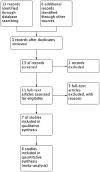Atosiban improves the outcome of embryo transfer. A systematic review and meta-analysis of randomized and non-randomized trials
- PMID: 32401462
- PMCID: PMC7558905
- DOI: 10.5935/1518-0557.20200016
Atosiban improves the outcome of embryo transfer. A systematic review and meta-analysis of randomized and non-randomized trials
Abstract
Objective: To estimate the effectiveness of Atosiban in improving the outcome after embryo transfer. The effectiveness of embryo transfer per cycle is still relatively low. One possible explanation might be uterine contractility that expels the transferred embryos. Atosiban improved the outcome of embryo transfer by reducing uterine contractility.
Methods: Data sources: A systematic review of papers in English using MEDLINE and EMBASE (1990-2019). Search terms included Atosiban, embryo transfer. Study selection: We included studies that compared the outcomes of embryo transfer with Atosiban and a control group. Data Extracting: Independent extraction of papers by two authors, using predefined data fields, including study quality indicators.
Results: All pooled analyses were based on a fixed-effect model. Four randomised controlled trials, including 1,025 women, and two non-randomised trials, including 686 patients, met our inclusion criteria. In both studies, the heterogeneity was moderate. Atosiban increased clinical pregnancy rates regardless of the indication for ART or type of embryo transferred. Pooled OR in randomized controlled trials reached 1.47 (1.18-1.82), and in non-randomised controlled trials it reached 1.50 (95% CI 1.10-2.05).
Conclusion: Atosiban appears to increase the clinical pregnancy rates in women undergoing embryo transfer.
Keywords: atosiban; in vitro; pregnancy rate.
Conflict of interest statement
There is no conflict of interest.
Figures
References
-
- Fanchin R, Righini C, Ayoubi JM, Olivennes F, de Ziegler D, Frydman R. Uterine contractions at the time of embryo transfer: a hindrance to implantation? Contracept Fertil Sex. 1998a;26:498–505. - PubMed
Publication types
MeSH terms
Substances
LinkOut - more resources
Full Text Sources
Miscellaneous




